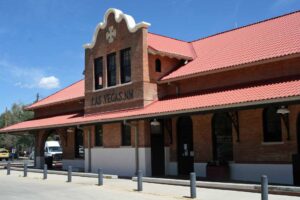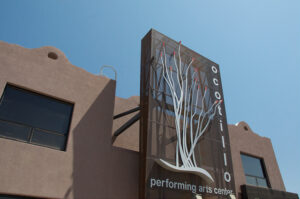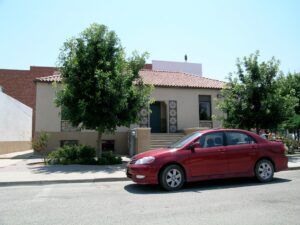The Mission Revival movement enjoyed its greatest popularity between 1890 and 1915, in numerous residential, commercial, and institutional structures - particularly schools and railroad depots - which used this easily recognizable architectural style. Drawing inspiration from the late 18th and early 19th century Spanish missions, the Revival style featured clay roof tiles, thick arches springing from piers, and long, exterior arcades, among other details.>
- Posts: 28 -
Gallup Cultural Center

Constructed 1918. The Amtrak stop in Gallup is a two-story stucco station built in 1918 in the Mission Revival architectural style. It was originally constructed to serve as an area headquarters for the Santa Fe Railway, the successor to the Atlantic and Pacific Railroad. A Harvey House hotel and restaurant, Read more…
Las Cruces Railroad Museum

Constructed 1910. The first Atchison, Topeka, & Santa Fe (AT&SF) train arrived in Las Cruces on April 26, 1881. The first depot was a wood frame building that was later moved on flatcars down the line to Al Tuna (present day Anthony, TX). The wood frame building provided passenger and Read more…
Las Vegas Railroad Depot

The Las Vegas Railroad Depot replaced an earlier wooden depot constructed after the Santa Fe RR arrived in July, 1879, making Las Vegas the first railhead in the NM Territory. The existing depot is one of the earliest buildings built in the trademark California Mission Revival style in NM. The Read more…
Lea County Museum

Constructed 1920. Lovington is the county seat of Lea County, it became a town in 1908 when settlers from east of the Texas line homesteaded the western edges of the Llano Estacado in New Mexico Territory. New Mexico became a state in 1912. Lea County was founded in 1917. The Read more…
Luna Theater

Constructed 1916. The Luna Theater was built in 1916, and opened as the Mission Theater. The building replaced an earlier mercantile building that stood on the corner and burned to the ground. The building is in a Mission Revival style with Art Deco fixtures that were added in the 1930s. Read more…
Lyceum Theater

Constructed 1921. The Lyceum Theater opened in 1921 with 899 seats, built for E.F. Hardwick with stage capacity for vaudeville shows and movies. It was designed in the Mission Revival style by the Boller Brothers, a popular architectural firm specializing in movie theaters. The Lyceum showed its first talking picture Read more…
Ocotillo Performing Arts Center

Constructed 1935. The Ocotillo Theater was built in 1935 by theater owner and developer C.W. Bartlett and his son Ray, who built and operated several historic theaters in Artesia. The Ocotillo was converted to a popular cafeteria in the 1950s. The Artesia Arts Council acquired the Ocotillo in 2001 and Read more…
Old City Hall

Constructed 1939. The Old City Hall was built with WPA funds in 1939. It is currently being used as an office building and is managed by Artesia MainStreet. As WPA (Works Progress Administration, a depression-era program) building project, it brought several City departments together under the same roof, including the Read more…
Old Pass Gallery/Wells Fargo Freight Office

Constructed 1910. The former Well Fargo Express Freight Office at the Raton Rail yard is now the home of the Raton Arts and Humanities Council and the Old Pass art gallery. The building has been handsomely rehabilitated and offers high quality art shows regularly throughout the year. 145 So. First Read more…
Old Post Office Building

Constructed 1934. The old Silver City post office was “built in 1934 by the Treasury Department. It is a one-story hollow tile construction with a basement. It has modified Mission-style arches, relief ornamentation and entablature with finials over front entrance, double-leaf front doors, transom covered by row of turned spindles, Read more…